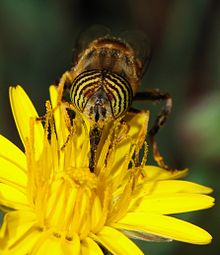Aproboscis(/proʊˈbɒsɪs,-kɪs/) is an elongated appendage from the head of an animal, either avertebrateor aninvertebrate.In invertebrates, the term usually refers to tubularmouthpartsused for feeding and sucking. In vertebrates, a proboscis is an elongatednoseorsnout.

Etymology
editFirst attested in English in 1609 from Latinproboscis,thelatinisationof theAncient Greekπροβοσκίς(proboskis),[1]which comes fromπρό(pro) 'forth, forward, before'[2]+βόσκω(bosko), 'to feed, to nourish'.[3][4]The plural as derived from the Greek isproboscides,but in English the plural formproboscisesoccurs frequently.
Invertebrates
editThe most common usage is to refer to the tubular feeding and sucking organ of certain invertebrates such as insects (e.g.,moths, butterflies,and mosquitoes), worms (includingAcanthocephala,proboscis worms) andgastropodmolluscs.
Acanthocephala
editTheAcanthocephala,the thorny-headed worms or spiny-headed worms, are characterized by the presence of an eversible proboscis, armed with spines, which they use to pierce and hold thegutwall of their host.
Lepidoptera mouth parts
editThe mouth parts ofLepidoptera(butterfliesandmoths) mainly consist of the sucking kind; this part is known as the proboscis or 'haustellum'. The proboscis consists of two tubes held together by hooks and separable for cleaning. The proboscis contains muscles for operating. Each tube is inwardly concave, thus forming a central tube up which moisture is sucked. Suction takes place due to the contraction and expansion of a sac in the head.[6]A specific example of the proboscis being used for feeding is in the speciesDeilephila elpenor.In this species, the moth hovers in front of the flower and extends its long proboscis to attain its food.[7]
A few Lepidoptera species lack mouth parts and therefore do not feed in theimago.Others, such as the familyMicropterigidae,have mouth parts of the chewing kind.[8]
The study of insect mouthparts was helpful for the understanding of the functional mechanism of the proboscis ofbutterflies(Lepidoptera) to elucidate the evolution of new form-function.[9][10]The study of the proboscis of butterflies revealed surprising examples of adaptations to different kinds of fluid food, includingnectar,plant sap,tree sap, dung[11][12][13]and of adaptations to the use ofpollenas complementary food inHeliconiusbutterflies.[14][15]An extremely long proboscis appears within different groups of flower-visiting insects, but is relatively rare.
Gastropods
editThis sectionneeds expansionwith: more information, examples, and links.. You can help byadding to it.(August 2023) |
Someevolutionary lineagesofgastropodshave evolved a proboscis. In gastropods, the proboscis is an elongation of the snout with the ability to retract inside the body; it can be used for feeding, sensing the environment, and in some cases, capturing prey or attaching to hosts. Three major types of proboscises have been identified: pleurembolic (partially retractable), acrembolic (fully retractable), and intraembolic (variable in structure). Acrembolic proboscises are usually found inparasiticgastropods.[16][17]
Vertebrates
editThe elephant's trunk and thetapir's elongated nose are called "proboscis", as is the snout of the maleelephant seal.
Notable mammals with some form of proboscis are:
- Aardvark
- Anteater
- Elephant
- Elephant shrew
- Hispaniolan solenodon
- Echidna
- Elephant seal
- Leptictidium(extinct)
- Moeritherium(extinct)
- Numbat
- Proboscis monkey
- Saiga antelope
- Members of thetapirfamily
Theproboscis monkeyis named for its enormous nose.
The human nose is sometimes called a proboscis, especially when large or prominent.
See also
edit- Beak– Part of a bird
- Nostril– Nose orifice that enables the entry and exit of air.
- Rostrum (anatomy)– Anatomy term
- Snout– Extended part of an animal's mouth
References
edit- ^προβοσκίς, Henry George Liddell, Robert S,A Greek–English Lexicon,on Perseus Digital Library
- ^πρό,Henry George Liddell, Robert Scott,A Greek–English Lexicon,on Perseus Digital Library
- ^βόσκω,Henry George Liddell, Robert Scott,A Greek–English Lexicon,on Perseus Digital Library
- ^Harper, Douglas."proboscis".Online Etymology Dictionary.
- ^Amin OA, Heckmann RA, Ha NV (2014)."Acanthocephalans from fishes and amphibians in Vietnam, with descriptions of five new species".Parasite.21:53.doi:10.1051/parasite/2014052.PMC4204126.PMID25331738.Art. No. 53.
- ^Evans, W. H. (1927)Identification of Indian Butterflies,The Diocesan press. Introduction, pp. 1–35.
- ^Hallam, Bridget; Floreano, Dario; Hallam, John; Hayes, Gillian; Meyer, Jean-Arcady (2002).From Animals to Animats 7: Proceedings of the Seventh International Conference on Simulation of Adaptive Behavior.MIT Press.ISBN9780262582179.
- ^Charles A. Triplehorn and Norman F. Johnson (2005).Borror and Delong's Introduction to the Study of Insects(7th edition). Thomson Brooks/Cole, Belmont, CA.ISBN0-03-096835-6
- ^Krenn HW, Kristensen NP (2000). "Early evolution of the proboscis of Lepidoptera: external morphology of the galea in basal glossatan moths, with remarks on the origin of the pilifers".Zoologischer Anzeiger.239:179–196.
- ^Krenn HW, Kristensen NP (2004)."Evolution of proboscis musculature in Lepidoptera"(PDF).European Journal of Entomology.101(4):565–575.doi:10.14411/eje.2004.080.S2CID54538516.
- ^Krenn HW, Zulka KP, Gatschnegg T (2001). "Proboscis morphology and food preferences in Nymphalidae (Lepidoptera, Papilionoidea)".J. Zool. Lond.253:17–26.doi:10.1017/S0952836901000528.
- ^Knopp, M. C. N.; Krenn, H. W. (2003). "Efficiency of fruit juice feeding inMorpho peleides(Nymphalidae, Lepidoptera) ".Journal of Insect Behavior.16(1):67–77.Bibcode:2003JIBeh..16...67K.doi:10.1023/A:1022849312195.S2CID33428687.
- ^Krenn, Harald W. (2010)."Feeding Mechanisms of Adult Lepidoptera: Structure, Function, and Evolution of the Mouthparts".Annual Review of Entomology.55:307–27.doi:10.1146/annurev-ento-112408-085338.PMC4040413.PMID19961330.
- ^Krenn, Harald W.; Eberhard, Monika J. B.; Eberhard, Stefan H.; Hikl, Anna-Laetitia; Huber, Werner;Gilbert, Lawrence E.(2009)."Mechanical damage to pollen aids nutrient acquisition inHeliconiusbutterflies (Nymphalidae) ".Arthropod-Plant Interactions.3(4):203–208.Bibcode:2009APInt...3..203K.doi:10.1007/s11829-009-9074-7.PMC4040415.PMID24900162.
- ^Hikl, A. L.; Krenn, H. W. (2011)."Pollen processing behavior ofHeliconiusbutterflies: A derived grooming behavior ".Journal of Insect Science.11(99): 99.doi:10.1673/031.011.9901.PMC3281465.PMID22208893.
- ^Simone, Luiz (September 2019)."The proboscis of the Gastropoda 1: its evolution".Malacopedia(Volume 2(4): 22–29 ed.).ISSN2595-9913.
- ^Ball, A.D. and Andrews, E.B. and Taylor, J.D. (1997-02-01)."THE ONTOGENY OF THE PLEUREMBOLIC PROBOSCIS INNUCELLA LAPILLUS(GASTROPODA: MURICIDAE) "(PDF).Journal of Molluscan Studies.63(1):87–89.doi:10.1093/mollus/63.1.87.ISSN0260-1230.
{{cite journal}}:CS1 maint: multiple names: authors list (link)